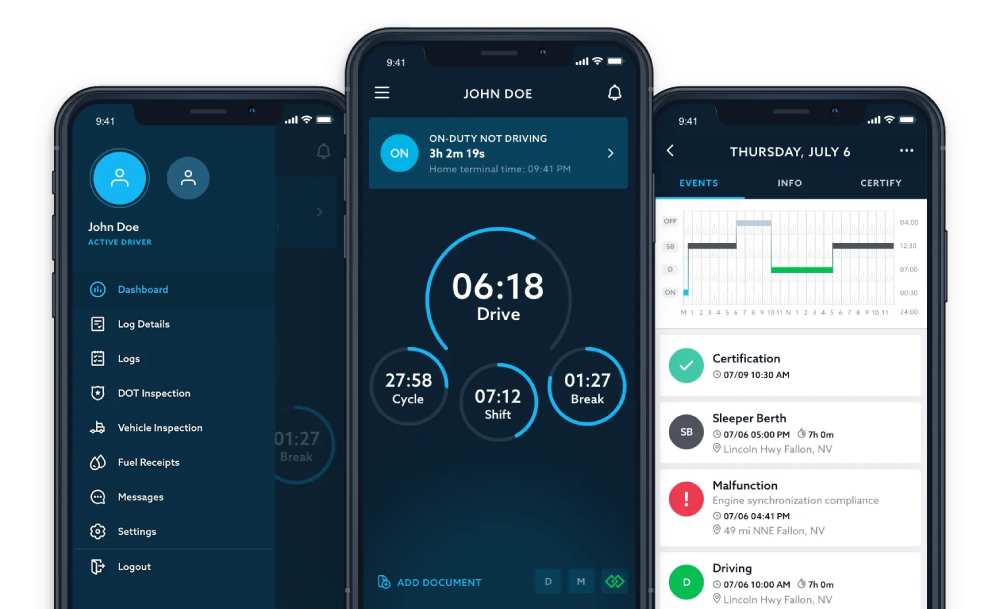Step-By-Step Installation and Training Guide for Electronic Logging Devices
Compared to paper logs, ELDs save drivers 15-30 minutes per day and several hours a week for fleet managers. Fleets should look for vendors who offer affordable pricing options and easy-to-install device options.
Look for a vendor that offers FMCSA-approved devices and a clear cost structure with no add-on fees. Samsara’s all-inclusive software system is simple to install and easy for drivers to learn. Request a free trial today.

Set-Up
Whether buying an ELD for the first time or switching to one from an AOBRD, it is critical to understand how these tools work. They are designed to meet FMCSA regulations while providing trucking companies various other benefits.
Electronic logging devices (e-log) record CMV drivers’ driving time in real-time, making it easy to see their HOS status without referencing paper logs. It also collects vehicle data such as date, location, engine hours and miles, driver identification, authenticated user, and motor carrier.
This information is analyzed to provide fleet managers with detailed reports, giving them the tools to reduce fuel consumption and improve efficiency. This allows delivery companies to keep their customers happy while reducing costs for everyone involved. The top-rated ELDs can even save dispatchers a significant amount of time, as they’ll have access to the same reports as their drivers in real-time.
Connect
ELDs connect to a commercial motor vehicle (CMV) engine and automatically record data that ensures the integrity of driver records of duty status, or RODS, and compliance with hours-of-service regulations. They are also used to transmit tracking data and GPS tracking information. Delivery businesses, for example, use ELDs to send real-time ETA information to customers and improve on-time performance.
While most trucking software providers offer several different ELD devices, selecting one that meets your business needs and budget is important. It is also crucial to look for an ELD with an easy-to-use interface that drivers and fleet managers will be comfortable using. Additionally, you should consider the cost of additional hardware and add-on fees that some ELDs require. Many ELD providers offer a thirty-day trial period to help you decide which device is right for your business.
Install the ELD
You must consider several factors when selecting an ELD solution for your fleet. First, choose a device that is FMCSA-approved and obeys all federal regulations. It must also be relatively easy to install and use. Some products require removing a plastic cover, while others can be fitted to the vehicle diagnostic port. This connector will be either 9-pins or 6-pins, and the driver must line up the collar tabs on the device to match the diagnostic port’s slot exactly and press firmly until it clicks.
Lastly, look for an all-inclusive platform with no add-on fees. This will ensure that your drivers and fleet have all the features they need for compliance without paying extra.
It is important to plan the rollout of your new ELD system during a less busy operational period so that downtime is minimal. However, even if this is not possible, training your drivers on the new equipment is critical so they know how to use it.
Training
The ELD solution should include a GPS tracking feature that will send data to dispatchers on the truck’s real-time location. This can help fleet managers monitor drivers’ performance and safety while on the road. It also allows freight forwarders to see when trucks are in a construction zone or speed limit violation.
Using ELDs makes it easier for fleet owners to manage HOS compliance while reducing administrative work and improving vehicle and driver safety. However, truck drivers and operators may be skeptical of the benefits. This is why it’s important to roll out the device during a less busy operational period and provide comprehensive training before switching.
ELDs digitally record a driver’s Record of Duty Status, replacing paper logbooks and ensuring compliance with Department of Transportation (DOT) rules. They automatically connect to the engine and capture movement, allowing the driver to manually select whether they’re on-duty, off-duty, or in their sleeper berth.


